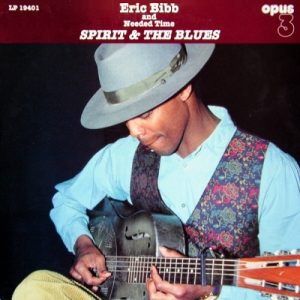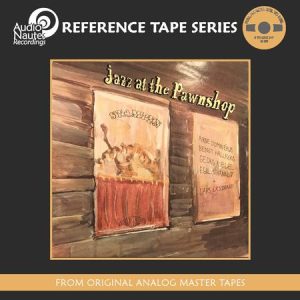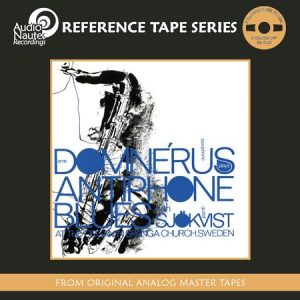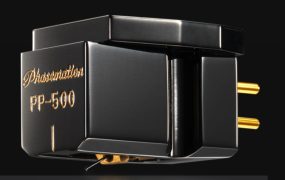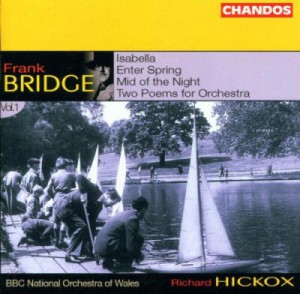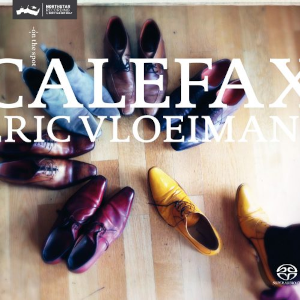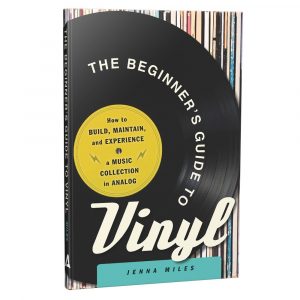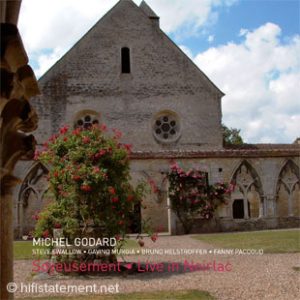When all is said and done, it's all about the source material. The better the source material, the better the system sounds. (It's amazing how a master tape can make bad speakers sound like a million dollars!) The best source here being 15-ips reel-to-reel tape.
Now making the best sounding consumer 15-ips, 2-track reel-to-reel tapes (and LPs) requires getting as close to the original master tape as is humanly possible. The vast majority of today's real time duplicated, 15-ips tapes are third generation copies sourced from either 30-ips/½-inch or 15-ips/½-or ¼-inch running master (s) copies of the master tape. And at their very best simply stunning sounding.
But not all as the Opus 3 tapes are a direct copy of the master tape! Record labels adopted this methodology to avoid unnecessary wear and tear on those fragile and in oh-so many cases 50 plus year old irreplaceable pieces of history. In other words, avoiding running those master tape 50, 100, 150 or more times to produce individual tape copies. In some cases, one (AudioNautes, Opus 3, etc.) and in other cases two to as many as eight tape copies are made at a time (The Tape Project, Analogue Productions, 2XHD Fusion, etc.).
The Cream Of The Crop
Fourteen years have passed since my first piece on the renaissance of interest in 15-ips reel-to-reel tape (and machines) appeared in the pages of Positive Feedback. (HERE) Since that first article, the number of companies releasing music on 15-ips reel-to-reel tapes has grown by leaps and bounds. New titles are being released monthly and the high-end audio tape audiophile market has seen the entry of many new companies such as 2XHD Fusion, AudioNautes, UltraAnalogue, HyperAnalogue, Horch House (well, a reboot here), among many others.
A Baker's Dozen of the finest examples (and there's far more) of today's state-of-the-art in real time duped 15-ips tape releases include:
- ** Bill Evans: Some Other Time (2XHD Fusion/MPS Records)
- **Cantate Domino (Audionautes/Proprius Records)
- *Davey Knowles: Still Got Some Work To Do (International Phonograph, Inc.)
- *Joe Policastro: Vibes Quartet (International Phonograph, Inc.)
- *Nostos: Tes Mousikes/The Homecoming Music (Yarlung Records)
- *Suryodaya (Yarlung Records)
- **Bill Evans: Waltz for Debby (The Tape Project/Riverside Records)
- **Jerry Garcia and Dave Grisman (The Tape Project/Acoustic Disc)
- **Nat Adderley: Work Song (The Tape Project/Riverside Records)
- **Hugh Masekela: Hope (Analogue Productions/Triloka Records)
- **Moussorgsky: The Power of the Orchestra (Analogue Productions/RCA Living Stereo)
- **Muddy Waters: Folk Singer (Analogue Productions/Chess Records)
- *Jacintha: Here's to Ben Webster (Groove Note Records)
*New recording
**Reissue
So without further ado, here's a quartet of new, all analog reel-to-reel tapes that are right at home on the above list!
Eric Bibb and Needed Time, Spirit and the Blues, Opus 3 Records, Producer and engineer: Jan-Eric Persson; 15-ips, 2-track reel-to-reel tape; Equalization: CCIR/IEC; Distributed (US) by Elusive Disc, Price: $549 (two reels).
Opus 3 is one of two legendary Swedish music labels—the other being Proprius Records—featured in this piece. Jan-Eric Persson's recordings still to this day set benchmarks for others record labels to aspire to when it comes to transparency, resolution and bass quality. Much of that sonic sorcery is directly traceable to owner, producer and engineer Persson's recording philosophy. Persson, as on his other recordings, used a simple and purist Blumlein microphoning technique consisting of that legendary AKG C24 vacuum tube microphone (with old capsule) and a Neuman U-89 microphone on the bass. Still, one certainly can't dismiss the contribution of tubes in the signal path, that legendary Telefunken Magnetophon M28C tape machine and the acoustics of the recording space!
Persson made news at the 2012 Winter CES with the announcement that Opus 3 would be releasing 50 selected titles from the label's large stable of recordings on 2-track, 15-ips reel-to-reel tape. Along the way, Persson also released a series of amazing sounding sampler tapes tailored for those looking to dip their toes into the tape waters or tapeheads unfamiliar with the Opus 3 catalog. A try before your buy special. While the Opus 3 reel-to-reel sampler tapes afforded a mouthwatering taste of the Opus 3 sonic magic, it's nothing like the startling transparency and unfettered instrumental transient attack experienced on the second generation copy of Eric Bibb's Spirit and the Blues. That's coupled with a limitless soundstage filled with three-dimensional bodies and layering!
Spirit and the Blues proved special, too, in another way. This (and all Opus 3 tapes) are direct copies of the original master tape. Nothing could sound better save having the original master tape in your hands! Each Opus 3 tape is made to order and is delivered roughly directly from Sweden roughly one month after ordering. The downside? Each Opus 3 title is limited to a maximum of 50 copies.
Finally, this is a perfect title for the reel-to-reel format. Spirit and the Blues was originally a double LP consisting of fifteen songs and because of this length completely fills two 10-inch reels (each reel with 1.5 mil tape holds roughly 32 minutes of music) and gives owners their musical money's worth. That's in contrast to other reel-to-reel releases—through no fault of their own—that contain only 18 to 22 minutes or so of music.
One would be extremely hard pressed to find a better sounding reel-to-reel tape than Spirit and the Blues. The music here—unlike many albums where the first two songs are sensational, and the rest are eminently forgettable—only becomes progressively better with each succeeding track! Sonically, Spirit and the Blues possesses a simply mouthwatering midrange tone in addition to an extraordinary sense of presence of the instruments and singers. Musically, one finds a several new songs written by Bibb along with a mix of blues, gospels and some good pickin' music from the likes of Woody Guthrie, Blind Lemon Jefferson, Odetta and several others. Oh, yes. Persson also revealed to me at that CES 2012 that Eric Bibb is, "his favorite artist to work with." Bibb is accompanied on Spirit and the Blues by the Deacons gospel quintet, Goran Wennerbrandt on bottleneck (steel) guitar among others.
Reel A kicks off the festivities with Bibb's rendition of Woodie Guthrie's "Lonesome Valley," a little romp with a discernable shuffle feel (so wonderfully described by Branford Marsalis HERE). Bibb is front and center on this track and the room is filled with wall-to-wall sound.
That cut is followed by "In My Father's House," with that traditional blues call and response and featuring Wennerbrandt on his trademark bottleneck guitar and The Deacons. Without doubt, the real highlight here is the contrast between Bibb's and Wennerbrandt's 1931 steel National bottleneck guitar. The music is utterly effortless and is accompanied by a generous helping of that renowned Opus 3 recording transparency. It's also impossible to miss that wonderful vocal, midrange tonality and how Deacons are anchored and separated across the back of the soundstage. Absolutely clearly rendered.
Next up is arguably one of the three best sounding tracks on the tape. In fact, it's worth buying Spirit and Blues just for "Needed Time" and its incredible instrumental presence, sound of the mandolin and low end. Not to mention perhaps the finest example of the sound of Goran's bottleneck guitar!
"Where Shall I Be" showcases Bibb's instrumental solo and fingerpicking style. This track just has it all: clarity, transparency, detail, speed all rolled into one.
That's followed by "Woke Up This Mornin'," a little Southern Baptist ditty and "a song popularized during the Civil Rights movement and made famous by the Freedom singers." All one needs to round out the picture is a tent in the living room and a few Halleluiah's! Here again, Bibb is accompanied by the Deacons quintet with the singers spread out from wall-to-wall. The Deacons let all hang out with their exuberance, singing, phrasing on this song. With a distinctive and realistic tonality to each singer's voice.
"I Want Jesus to Walk With Me" is another serious contender for best sounding track on Spirit and the Blues. This track has it all. A simply amazing sounding midrange. Airiness. Guitar detail and decay. It's all here in spades.
And that's only Reel A, and there's two packed reels of Bibb. The second reel begins with "You Gonna Need Somebody" and it's as if Bibb and his guitar are in the room with you. And the quiet accompaniment is just that—super quiet. Track three, "Water Under The Bridge," again contrasts Bibb and Goran playing their guitars, Bibb fretting and Goran Wennerbrandt sliding. It's so intimate and possesses an uncanny feeling of them sitting side by side playing. Stunning sounding midrange realism—a lack of artificiality—and feeling of tension.
The remaining tracks on Reel B are both a musical and sonic extravaganza with all the different instruments and compositions by Bibb and others. Then finally Bibb and company releases the tension and brings everyone back to the roots with that beautiful instrumental version of "Waltz."
Spirit and the Blues is one tape that belongs in every tapehead's music collection!
Technical Details
- Analog recorder: Telefunken Magnetophon M-28C
- Microphones: AKG C-24 vacuum tube stereo microphone and Neumann U-89
- Mixer: custom built vacuum tube design
- Recording tape: BASF SM-468
- Recorded: January-June, 1984
Jazz at the Pawnshop, Producer: Jacob Boethius, Engineer: Gert Palmcrantz; Recorded at the Pawnshop (Stampen) Jazz Club, Sweden; Audionautes/Proprius Records AN-RTR-2203, 15-ips, 2-track reel-to-reel tape; Equalization: CCIR/IEC; Distributed (US) by Acoustic Sounds, Price: $1899.98 (four reels).
It's with great sadness along with great fondness that I remember my late friend (and mentor) Sid Marks ("Mark's Barks" of The Absolute Sound and later my magazine Ultimate Audio) love for Proprius Records' recordings. Especially those Bert Alving organ recordings that allowed Sid to show off the capabilities of his Infinity RS1b speaker's woofer towers! It was such a great time to be an audiophile in the ‘80s with its unfettered optimism and unbridled enthusiasm.
One of Proprius Records' most well-known and legendary releases is the live recording Jazz at the Pawnshop. This album achieved an almost unheard of, overnight, cult-like status among audiophiles after its release in 1977. (Geez, how time flies!) Back then, I was just a knee high to grasshopper tall audiophile and what did I know? Over the years, however, I've developed a deep appreciation for the transcendent magical quality of the best live jazz recordings and their ability to transport you back in time. For example, Bill Evans' Waltz for Debby/Sunday at the Village Vanguard, Shelly Manne at the Blackhawk vol. 1 or Mel Torme Live at Shorty's, make having a high-end system worth its weight in gold pressed Latinum! That went double during the pandemic when live musical events were cancelled! Jazz at the Pawnshop possesses all of those magical qualities and a few more.
Legendary alto saxophonist Arne Domnerus was accompanied those two nights by a number of noted Swedish jazz musicians including Lars Erstrand on vibes, Bengt Hallberg on piano, Egil Johansen on drums and George Riedel on bass. (You'll also find these musicians on other Swedish labels such as Opus 3 and Phontastic.). Those two nights eventually gave rise to three LPs and one CD release. These included the original Jazz at the Pawnshop LP as well as Jazz at the Pawnshop 2 (Proprius Records 9544, released in 1991) and Good Vibes at the Pawnshop Jazz Club (Proprius Records 9558, released in 1991) on vinyl; Jazz at the Pawnshop 4 was according to Fabio Camorani of AudioNautes only released in a digital format and according to my audiobuddy Ki Choi, gifted to a select few by the owner of Proprius Jacob Boethius.
Jazz at the Pawnshop 2—of the two LP subsequent releases—is as good sounding, if not better, than the first release (and the tape probably much fresher than the first tape). Jazz at the Pawnshop 2 was just released by Audionautes (2 reels) and a review is forthcoming. The sound on Jazz at the Pawnshop 3 is sadly not up to the standards set by the previous two releases. Here according to Fabio, "one can feel by the second night of December 7th, that they are tired, very tired. No one was very young, they played very softly, without energy, sound is going down, not the bad dynamics of the microphones." (I'm not sure that I agree about the microphone statement—or at least whether the microphone placement was the same on the second night as used on the opening night.) Whatever the case, the difference in sound between Jazz at the Pawnshop 1/2 albums and Jazz at the Pawnshop 3 is day and night. In fact, the only resemblance between the first two LPs and third is purely coincidental.
And talk about walking on hallowed ground! There's only four people outside of Proprius Records to ever to handle these tapes. That esteemed list includes Winston Ma/Ki Choi (First Impressions Music), Joerg Kessler (ATR Mastercuts) and most recently Fabio Camorani (AudioNautes) and Rene LaFlamme (2XHD Fusion). (I'm not sure why there isn't a copy of the FIM Jazz at the Pawnshop in not in my collection!) The scarce FIM reissue—cut from the same master tape as the current AudioNautes reel-to-reel reissue, is currently fetching $300 and more on Discogs.) Too much is always just enough and Rene LaFlamme and 2XHD Fusion has also released their own version of Jazz at the Pawnshop (though only half of the original LP release) and will soon be releasing another tape entitled Late Night New Unreleased Tapes with even more cuts from those two nights. Cost, unfortunately, prevented me from comparing the 2XHD Fusion with the AudioNautes tape releases of Jazz at the Pawnshop.
Back to the original Jazz at the Pawnshop release. Discogs.com lists 24 different analog pressings of Jazz at the Pawnshop (65 in total with CD, SACD, digital files and even cassettes!) on its website. The list starts with the original 1977 ½-speed, gatefold album mastered by Jack Hunt/JVC and distributed in the US by the audiophile LP distributor Audiosource.
Jazz at the Pawnshop represents a curated musical compilation taken from the many 7-inch reels/songs recorded by Gert Palmcrantz those two evenings and put on two LPs. The album's title is derived from the club where the recordings took place. Stampen Jazzhause has seen many lives including at one time being a French Reformed Church and later a pawnshop located in the old town of Stockholm. "Stampen" is derived from "the stamps clients would receive per maintenance payment for items they had deposited at the pawnshop." Then in 1968, the building became a jazz club and has stayed that way ever since. As per the website, "from church premises to pawn shop to jazz club" and has now been hosting music for 55 years now. Pictures of the club can be found HERE.
Palmcrantz used a portable Nagra IVs reel-to-reel tape machine equipped with seven-inch reels and the Nagramaster EQ curve to record these sessions. (The problem having used the Nagramaster curve is that very few mastering engineers today are set up to use this curve.) Fabio also revealed a few more facts about the making of this audiophile standard with me. "First, there wasn't a lot of preparation beforehand. Gert Palmcrantz said he started without any preparation, simply let's go." That was reflected, for instance on the first track on the first reel marked Stampen 1, where Fabio found nothing below 1 kHz. Fabio then added, "music for a couple of minutes, then the music stopped. Then the double bass comes in and Pomecrantz is still fiddling with the equalization and at one point the double bass is 5 dB or more than normal. In the end, there's twelve minutes of trial and error." He continued, "then the second reel labelled Stampen 2, continues and in the ends starts to sound pretty good and then we get to what was released as Jazz at the Pawnshop; As the sessions go on into the night," the sound according to Fabio, "gets darker and less dynamic.
The Jazz at the Pawnshop 2 tapes," said Fabio, "are fantastic and even more dynamic!" Fabio added, "Side 1 being the more explosive of the two reels. Jazz at the Pawnshop 2 may also sound better because it was the less used/played of the master tapes."
Everything on AudioNautes' Jazz at the Pawnshop—just like their previous two tape releases—exudes pride of ownership. That includes a beautifully laid out 15-page, four color booklet that starts with an introduction and tribute to the label and recording by Fabio Camorani. The booklet also contains extended notes about the recording by Stefan Nevermyer, pictures and descriptions of the original recording equipment plus Audionautes Otari MTR-15 duping setup, playback monitoring and evaluation system. Also included in the four-reel set are custom made reels, a certificate of ownership/serial number and a technical sheet.
Jazz at the Pawnshop—much like Waltz for Debby—is noted for its naturalness, instrumental viscerality, harmonic integrity and decay and dynamics. On the very best systems, too, there's an eerie sense of being seated in the club. Jazz at the Pawnshop compared to Evans' masterpiece (here we're talking about The Tape Project 15-ips reissue) displays a little more direct, close-up sound without sacrificing the sense of the club's ethereal atmosphere.
As for the tape package. There's no shortage of music on these four 10-inch reels. Reel A isn't the best sounding of the four reels as Palmcrantz is still making audible adjustments. The first reel contains some unfamiliar tunes highlighted by the African tune "High Life." The first sounds off the tape are the quiet, anticipatory murmurings of the crowd eagerly awaiting the musicians to launch into their first song. And judging by all the rattling glasses, the crowd still hasn't settled down in track 2. Then the band with Domnerus on alto saxophone opens up followed by solos by Hallberg on piano, and Erstrand on vibes. Vibes solo can give vinyl playback systems fits but there's none of those issues on tape!
Palmcrantz's adjustments are beginning to reap benefits by the time we get to track three "I'm Confessin." Instrumental images are far more fleshed out though the upper octaves aren't quite settled in yet. There's a little more midrange and the musicians sound a little closer to mikes. The sound is a touch more dynamic too.
Then there's a great drum solo by Johansen and the band really starts to warm up and start swinging. The crowd is starting to settle down and get into the music! Oh, and the band fools the audience into thinking the song is over and then launches into a whole new vamping section with sax, vibes and drums. Then the tape runs out before the band finishes the song (this is on the actual recording and using 7-inch reels, not a problem with the reissue!).
The band really gets untracked on the B Reel and launches into some more familiar jazz tunes. There's some heavy hitting going on here with Louis Armstrong's "Struttin with Some Barbecue," Duke Ellington's "Jeep's Blues" and Coleman Hawkins' "Stuffy." Struttin' features the piano work of Hallberg. The band really gets down on track 2, "Jeep's Blues" with Domnerus leading the way on sax and showing off the effortless dynamic range of this recording. Plus the sound is noticeably better here.
Reel C is defined by the music's unfettered dynamics and speed especially on "Barbados." There's also definitely more feel of the audience here than the previous two reels and the bass levels are a little different. The sound is slightly better balanced, too. Palmcratz really pushed the limits of tapes here! This reel continues with three more classic jazz tunes including George Gershwin's "Lady Be Good," Jimmy van Heusen's "Here Is That Rainy Day" and Charlie Parker's "Barbados." "Lady Be Good" stands out first for the audience murmuring with even some lady shouting in the audience and second for Erstrand's vibes solo! "Here Is The Rainy Day" is arguably the best sounding cut of all on Jazz at the Pawnshop with Hallberg on piano and Johansen's high-hat work really standing out here. The sound of the piano and its decay is positively delicious here. Oh, something very funny must have happened based on the laughing in the audience.
The audience is jumping and still very much into the band as the final reel begins to spin. Here, as in Reel 3, Palmcrantz has really locked in the sound of the band in. First up is the classic Morgan Lewis/Nancy Hamilton ‘30s tune "How High the Moon" before the band breaks into an uptempo version of Paul Desmond's "Take Five." (the most popular jazz tune ever!) featuring a Johansen drum solo and lots of vamping by Domenrus, Riedel, Hallberg and Johansen. One can't help but love the head out. Last but not least here is the Matt Dennis composition "Everything Happens to Me."
AudioNautes has yet to reissue Jazz at the Pawnshop on vinyl but I did pick up a copy of the Chris Bellman mastered 2XHD Fusion reissue. The 2XHD Fusion reissue is definitely warmer and richer sounding, has more resolution and three-dimensionality than the original Jack Hunt half-speed or normal speed mastered album. Grab it while you can!
Technical Details
- Original recording equipment: Nagra IV x 2 reel-to-reel tape machines, 15-ips, Nagra curve, Dolby A361x2
- Microphones; Neuman U47 cardioids, KM56s, M49 cardioids, ORTF pattern
- Tape: BASF Studio Master 911
- Recorded: December 6-7, 1976
- Reissue Producer: Fabio Camorani
- Mastering engineer: Pietro Benini and Fabio Camorani
- Recording and playback machines: Otari MTR-15
- Tape: RTM SM900
- Reference levels: 320 nWb/m
- Cables: Bluesilver custom design
Arne Domnerus: Antiphone Blues, Arne Domnerus, alto saxophone and Gustaf Sjokvist, organ, Producer: Jacob Boethius, Recording engineer: Sonokonsult Hakan Sjogren; Recorded at Spanga church, Sweden, Audionautes/Proprius Records, 15-ips, 2-track reel-to-reel tape; (US) by Acoustic Sounds, AN-RTR-2204; Equalization: CCIR/IEC, Price: $999.98 (two reels).
Jacob Boethius, the renowned founder of Proprius Records, wrote in a 1974 ad that, "A small record company can't afford to put out bad discs. And you, the music lover, must be confident that what you buy is good." No truer words have been written! And the only thing that anyone can possibly wish for here is more music on each reel. Of course, Antiphone Blues was recorded in an era where the space limitations of an LP in mind.
Antiphone Blues features the late, great Arne Domnerus on alto saxophone and the renowned Gustaf Sjokvist on organ. Domnerus, considered a jazz pioneer in post-war Europe, played with the likes of Charlie Parker, Clifford Brown, Art Farmer, Quincy Jones and many others. Domnerus is accompanied by Gustaf Sjokvist who had served as Director of Music, Choral Director, conductor and musician was featured on many Proprius recordings.
Antiphone Blues, as with all AudioNautes' reel-to-reel releases, comes with a beautifully laid out, 12 page, four color booklet that begins with a short introduction by Fabio Camorani to the Proprius label and the recording of Antiphone Blues. Inside the booklet are also pictures of the beautiful La Spanga church where the recording took place, information and pictures of the original recording equipment as well as the tape duping setup and biographies of the late Arne Domnerus and Gustaf Sjokvist, among other things. According to Fabio of AudioNautes, "the original engineer of Antiphone Blues session Hakan Sjogren is 85 and still alive." He continued, "it's a strange recording with only two Pearl mikes used, but each comes with fully independent double [rectangular]-diaphragms. According to Sjogren, because there were two capsules in each microphone, two channels were used per microphone in the mixer. I could then, at the time of the recording, choose how much of the rear channel would be included in the stereo image." Fabio reckons this setup was responsible for capturing the spaciousness and imaging of Antiphone Blues. The booklet concludes with bios of the late Arne Domnerus and Gustaf Sjokvist.
Many Swedish record labels of the day (take for instance, Proprius, Opus 3, BIS) featured recordings done in old churches and this recording is no different. Old here being European centuries, not US years! Antiphone Blues was recorded at the roughly 800 year old La Spanga church in Stockholm. The recording comes with a healthy dose of church acoustics and the lowest registers of the organ are incredibly solidly rendered. Fabio noted, "the organ is on the left on the original tapes. Other LP releases had the organ on the right. I don't know why someone changed the two channels." Fabio decided to keep the organ on the right for the AudioNautes LP reissue for uniformity and on the left as on the master tape for the reel-to-reel tape. Somehow that's not quite what I heard with my system. Here, Domnerus is mainly on the right side of the stage (with echo and/or bleed putting him occasionally in the middle) with organ spanning the back orf the stage on Reel A. On Reel B, Domnerus is more centered in the middle of the stage on most cuts. (I did have an audiobuddy play his LP to compare and confirm his findings.)
Antiphone Blues features a wide variety of music encompassing everything from Ellington to Schumann to Vivaldi to compositions by Domnerus. The album rekindles memories of the wonderful Gary Karr and Harmon Lewis double bass and organ recordings. Or the Opus 3 reel-to-reel tape Live at Vatnajokull with percussion and organ. Except instead of double bass and organ, Sjokvist paired saxophone with organ on Antiphone Blues. Today, this might be considered a jazz/classical music mashup.
What really sets Antiphone Blues apart from other church recordings is Sjogren's ability to carefully craft a balance between the direct and reflected sound of the church. Especially here where Sjogren didn't let the direct nor reflected sound of the organ overwhelm that of the saxophone. These types of recordings severely test the mettle of an audio system—particularly when it comes to not exaggerating the size of the Karr's double bass—or in this case Arne Domnerus' alto saxophone. One, however, isn't going to find on Antiphone Blues the sort of jaw dropping lows of the double bass or organ of the Gary Karr recordings. Instead, the musicians play down to each other and the organ is a little reserved and not going to overpower the saxophone. Domnerus takes the lead on some cuts, Sjokrist takes the lead on other cuts and yet on other cuts the two musicians play wonderful duets.
This recording—in large part due to the unusual pairing of saxophone and organ and ethereal-like quality—really grew on me. The first reel starts off with a mashup of Sjokrist doing "Almighty God" from Sacred Concert #2 and Domnerus playing Duke Ellington. Domnerus begins the duet and then Sjokrist joins in on organ. Both instruments possess an amazing solidity and the upper registers of the organ add to the church acoustics. It's all capped off by the decay of the Domnerus' saxophone at the end of the piece.
That's followed by the quiet and soft sounding spiritual "Nobody Knows The Trouble I've Seen." This piece is introduced by the organ effortlessly motoring along in own registers. Domnerus then enters after the extended introduction and then the organ gets down to business with its low end. This piece can be summed up in one word: delicacy.
Next up is the title track "Antiphone Blues." Domnerus and Sjokrist continue their interplay and it's even more apparent on this jazzy blues/classical mashup with a call and response between the two instruments. Here again is Sjokrist playing Sacred Concert #2 and Domnerus doing his best Ellington. The organ playing traditional church hymn music, Domnerus on saxophone with punctuating jazz solos. Ending with Amen and deep breath out!
The traditional Swedish hymn "Jag Ver En Delig Rose" is definitely going to wake up the bass fanatics. Yet, this isn't a bombastic track and anyone looking for sonic blockbusters should look elsewhere. This music really highlights a system's soundstaging and ability to capture and resolve the tape revealed, subtlest musical information. Sjokrist's organ provides the musical foundation, Domnerus' sax soars above the music. The overwhelming feeling is of the organ playing the role of a double bass at times here. This track also has a touch less ambience allowing the instruments to punch through more.
Reel B is a bit better sounding than Reel A. For whatever the reason—tape aging, recording on different days or places or the resolution of my system, etc.—I've observed sonic differences between reels on some releases. Domnerus and Sjokrist are tightly locked in Track 3, "Entonigt Kilngar Den Lilla Klockan, a Russian vesper song. This piece starts out with another delicate and beautiful duet between Domnerus and Sjokrist. In it is a beautiful Domnerus sax solo and Sjokrist's organ giving a flute-like feel at times, a sax at other times, etc. Sjokrist's organ for those keeping track of such things goes the lowest among the lowest the tracks on Antiphone Blues! The rest of the reel featuring tradition a traditional Swedish hymn Den Signacle Dag and concludes with "Largo" from Vivaldi's Concerto for Piccolo Flute and Orchestra C Major, RV176: II.
Fear not if you don't have a reel-to-reel tape deck! There are several choices including the original 1975 Proprius release (that apparently came with different covers), the 1982 Joerg Kessler remastered ATR Mastercut Recording and the recently released 2019 AudioNautes version. Suffice it to say the most recent AudioNautes LP is the preferred version. The original Proprius Records for all its positive qualities, is a little lean and lacks the bass extension of the other LPs and the 15-ips tape. The ATR Mastercut Recording gives you more of the weight of the organ but loses some of the original session's spaciousness. The most recent AudioNautes reissue brings together the best of both worlds combining the weight of the organ, the ambience of the recording venue and precise location of Domnerus!
Antiphone Blues is a wonderful addition to the ever increasing tape collection!
Technical Details
- Original recording equipment: Rebuilt Revox and two Pearl microphones in four-channel mixing
- Remaster Producer: Fabio Camorani
- Mastering engineer: Pietro Benini and Fabio Camorani
- Recording and playback machines: Otari MTR-15
- Tape: RTM SM900
- Reference levels: 320 nWb/m
- Cables: Bluesilver custom design
Norah Jones, Come Away With Me, Producers: Arif Mardin, Norah Jones and Jay Newland, Craig Street; Recording engineers: S. Husky Hoskulds and Jay Newlands; Recorded at: Sorcerer Sound (NYC, NY) and Allaire Studios (Shokan, NY); Analogue Productions/Blue Note Records RRAP 0022, 15-ips, 2-track reel-to-reel tape, Equalization: CCIR/IEC; Price: $450 (two reels).
I'm going to go out on a limb and predict that some tapehead (s) will wear out their copy Come Away With Me. Yes, this Norah Jones tape is that good! So a word of advice. Buy a copy of the Analogue Productions LP and reel-to-reel tape and only play the tape on special occasions when the audiobuddies drop by!
The most commonly objection to going down the tape rabbit hole is the paucity of rock and pop titles on reel-to-reel tape. Enter Norah Jones' 2002 debut and multi-Grammy Award winning album Come Away With Me. And what a debut album it was! Come Away With Me was an instant hit coming in at number 54 on Rolling Stones' list of 100 Best Albums of the Decade. Come Away With Me swept the 2003 Grammys with eight awards including: Breakthrough album; Best New Artist; Record of Year; Song of the Year: "Don't know Why"; Album of the Year; Best engineered album (non-classical): S. Husky Hoskulds and Jay Newlands. Jones' debut album had as of 2016 sold 27 million copies making Come Away With Me one of the best selling albums of all time.
All was not smooth sailing, though, with the recording of "Come Away With Me." According to Blair Jackson in Mix Online (4/1/2003), Jones' Come Away With Me, "had," according to late producer Arif Mardin at the Grammys that year, "a bit of a rocky beginning. He [Mardin] was brought into the project by Blue Note president Bruce Lundvall after Lundvall was dissatisfied with some initial sessions completed by Jones and her band. At first, Jones was understandably intimidated to work with the man who made hit after hit with Aretha Franklin, Chaka Kahn, Better Midler, The Bee Gees and countless others. But we had a meeting, and I said, Look, I'm working for you. It's your record, it doesn't matter what I've done, it only matters that what you're going to do. So in August 2001, in a very pleasant three weeks, we finished almost the whole album at Sorcerer Sound {in New York City}, mostly recording live," said Mardin.
Come Away With Me engineer Jay Newland recalled that, "Norah wasn't even signed when we recorded that song [‘Don't Know Why"]. We recorded 13 songs in two days. The guys came in, they all played live and we laid it down. Once signed to Blue Note, the only additions to the track were a second acoustic guitar and harmony vocals. Newland added, "Jones settled on a funny-shaped room with a drum booth in the back and two 6-foot x 6-foot booths in the middle, sort of like a railroad apartment. Norah was in the main room, playing the piano sand singing at the same time." (Chuck Taylor, Pro Audio Review, ‘Single Slice') Come Away With Me was recorded using two-inch Studer 820 24-track tape machines. A variety of classic mikes were used in the course of recording Come Away With Me including Telefunken U47 and RCA 44 (acoustic bass), Neumann M49 (vocals), B&K 4011 (piano), Neumann KM-84 (acoustic guitar), Telefunken U47 (overhead drums), etc. and Neve and Manley microphone preamps."
Jones' debut album with its blues, country, jazz standards, folk and soul elements proved also a huge crossover hit album, too! Replete with Jones' own gentle, soothing and innocent sound. The stripped down music allows Jones' piano playing and singing to come to the fore and absolutely dominate the ballad-like songs. All the cuts are short, sweet and to the point! Twenty-two-year-old Jones surrounded herself on Come Away With Me by top flight musicians including the likes of Bill Frisell, Adam Levy, Brian Blade, Jesse Harris, Lee Alexander and more.
People should know better by now than to question Chad's judgement in procuring and releasing albums. Yet procuring the rights to Come Away with Me was even a coup for him and Analogue Productions and he it out of the park on this release. The music only gets better and better with each succeeding track. There's not a throwaway song on Come Away With Me. Come Away with Me, in fact, is worth buying just for the title track Come Away With Me. But luckily, given the price of the tape, each song on Jones' album is a hit unto itself!
Reel A kicks off the musical festivities with Jonses' guitarist Jesse Harris' "Don't Know Why" and it only gets better with each successive song on this album. Jones' singing on "Don't know Why" is just highlighted by the recording's transparency and effortless sound. There's an uncanny feeling of Jones singing into the mike and how effortlessly she slides between notes. Not to mention it's all put together and packaged in a ginormous soundstage.
Or take Jones' rendition of the Hank William's ballad "Cold Cold Heart" and its striking opening bassline. Jones in the room with you and the breathiness of her singing is so striking. "Cold Cold Heart is also a great demo track to show off the system with its instrumental layering and tape revealed world of subtle, subtler and subtlest things going on here.
"Come Away With Me" really highlights Jones' ability to paint a picture with words. So simple, not lots of long verses, choruses or drawn out solos. This track really stands out in my mind, too, for the sound and resonance and decay of both Adam Levy's electric and Jesse Harris' acoustic guitar.
Last but not least on the first reel is that little blues spiritual "Turn Me On." Jones' words are so evocative and just brings out the deepest emotions (the lyrics are unfortunately missing from the enclosed sheet.)
Reel B stands out for its luscious and sensational variety of instruments. "Lonestar" featuring Tony Scherr on slide guitar kicks off the second reel on Jones' bass guitarist Lee Alexander penned song.
"Painter Song" conjures up a picture of sitting in a small bistro on the Left Bank of Paris, eating crepes and sipping a glass of wine. Especially listening to the accordion. "One Flight Down" is far and away my favorite tune on the album with Jones' breathy singing and little bigger sound. "Nightingale" is a hands down a sonic blockbuster and a galaxial kaleidoscope of sound. Topped off by the renowned Bill Frisell on guitar.
Reel B concludes with Jones' performing the classic Hoagy Carmichael tune "The Nearness of You." (For some reason, the lyrics of last tracks on the A and B reels were accidentally left off the tape insert.) Here we have just Jones singing and playing piano and leaving you hanging on every word and note. The song really highlights the sultriness of Jones' voice along with a hint of some Rickie Lee Jones for good measure. Just simply a romantic, emotional and sonic blockbuster. There's something system wrong with your system if you don't find yourself singing along to this tune!
For those analog devotees who spin 12-inch black discs. The Analogue Productions reissue—as well as the earlier Classic Records Clarity vinyl box set (with the Q/C issues such as having too small a center hole)—are terrific sounding alternatives, too!
There's no other way to say this. Come Away With Me might be one of the best recent additions to my reel-to-reel tape library in quite some time!
Technical Details
- Recording and playback machines: Ampex ATR-102 with Flux Magnetic heads
- Tape: RTM 468




